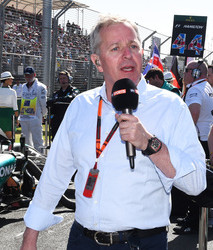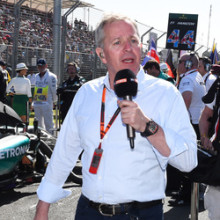Ask a pro
Receive advice directly from today’s top stars


Martin Brundle
Sky Sports F1 commentator and former F1 driver
Martin Brundle, Formula One’s award-winning commentator and former driver, is the latest online driving instructor for SAFEisFAST.com.
During an extensive career in F1 (1984-87, 1992-96) Brundle picked up numerous podium places and championship points. In between, he won the 1988 World Sportscar Championship and the 1990 Le Mans 24 hours.
It is in TV where he has picked up the most plaudits. In 1997, Brundle became a Formula One co-commentator alongside Murray Walker on ITV, where he was a fan-favourite, scooping the best sports pundit award on four occasions.
Martin Brundle answers your questions!
-
Beasty
What’s the best piece of advice you’ve received or the biggest lesson you’ve learnt that has given you the biggest increase in your performance?




Never underestimate your rivals, don’t assume anything about them being slower, less technically able, or poorer in race craft. Every day someone will surprise you otherwise. Always be fit and strong enough to drive cars at least one category above you, hopefully more. Be ready for any opportunity. Make the most of experienced people around you. I was lucky enough to get to know the likes of Sir Jackie Stewart. Sir Stirling Moss, Ken Tyrrell, Murray Walker and other great people. Old wise heads are usually delighted to share experiences and advice, the core of which still rings true decades later. The arrogance of youth makes it easy to think you know better and that they are out of date. Even today, at 56, I still don’t use this fountain of knowledge enough. It’s tough getting to the top, so use every short cut you can. Note that none of the above cost any money
-
Anonymous
Is it absolutely crucial to get into karting from a young age to get into, or be successful in F1?




These days learning race craft in karting from an early age seems extremely important on the ladder of motor racing success. But it’s not essential, if you have great talent but start a little later you can still make it to the top without karting, or at least have an enjoyable and successful racing career.
SAFEisFAST video: Karts to Cars
-
Anonymous
Competitive car or competitive driver? I know it’s a package but what’s your opinion?




The best drivers always end up in the best cars. They also help create the fastest cars through their feel and input because all the data and technical knowledge in the world still needs validating on track by the driver feeling instinctive, confident and committed. Of course not even the greatest such as Ayrton Senna will defy the laws of physics if there’s not enough power or grip. So instead they outperform what they do have, and soon get invited to drive the best. Therefore heads down and squeeze the most out of every opportunity, someone will notice.
-
Michael Martin
Is being quick in a race car a trait that a racer is born with or can it be learned? If it’s the latter, what are some steps one can take in order to be quick?




You can ‘learn’ to be a racing driver but in my opinion that will leave you a little mechanical in approach and lacking when conditions are challenging or at the big decisive moment in a race. You need an instinctive feel for grip and balance, along with bravery such that on a rainy day and you can’t see where you’re going you want to push the throttle a little harder, but also enough fear to survive. Otherwise track time, coaching and simulators can still make you a decent racing driver if you have the passion, determination and discipline.
-
Baptiste Vaila
I would like to make it into sports car racing, but I do not see how I can make it. Do you have any tips?



In many ways the sports car route is easier than single seaters. There are so many categories and most cars need three drivers, and you get a lot of track time. The gold/silver/bronze grading categories make less experienced racers welcome and essential. Also you can learn your trade in great cars such as Radicals for sensible costs, moving through GTs and hopefully onwards. Many countries have suitable sports car championships to get under way, good luck.
SAFEisFAST video: Getting Started
-
Ben Mulligan
Which would you prefer to drive, the F1 cars of your time or the F1 cars of today?




Today’s F1 cars all day long, no contest. I was lucky enough to drive two 2015 F1 cars (Mercedes and Force India) and I have driven over 40 F1 cars all told so feel qualified to say that. All the great cars, from Fangio’s 1954 Mercedes W196 to Hamilton’s 2015 championship winning Mercedes W06, had supreme balance and drive-ability despite widely differing power and grip. In the 80’s and 90’s when I raced F1 my job most of the time was to stop them crashing and keep them going to the flag. Then I’d spend hours in debriefings and days on track trying to make them a little better and faster. Now the cars are like an extension of your body and mind, they are everything I dreamed of in those tech debriefs. They are masterpieces of design and engineering, but it doesn’t make the racing better unfortunately.
-
Anonymous
When closely following a car ahead of you, do you mostly drive your own line or try to improve on what the car ahead of you is doing?




Firstly it’s important not to be too focused on the car in front, or mesmerised by it. Drive your car. If you close quickly on a rival, make an early move to pass if possible before they work out your strengths and weaknesses and are better able to defend. If you’re in an aero car you will most likely need to change your line to compensate for less grip and to help close in. At Le Mans in a sports car you tend to ‘show’ a little of your nose when following closely to keep some front aero especially over crests, and better visibility. Often you have to think of cooling too if you’re following for a long time on a hot day. Try to distract your rival by moving around in his mirrors. When you do go for the passing move make it clean, decisive, and don’t panic on the brake pedal and lock the wheels. Slow it all down in your mind.
-
Paul Huntington
Who is the quickest driver you’ve ever raced with or against? What made them so good?




Ayrton Senna had the most God given talent of any rival I raced against, and Michael Schumacher was the most complete. All the more tragedy then that one is dead and the other severely incapacitated. Senna knew where how high the grip was before and during a corner, not during and after with the benefit of hindsight. His passion and self belief drove him to new heights of controlling a car at, or just beyond, the perceived limit. Michael Schumacher had great speed and applied that to every aspect of making a winning racing team and car, and race strategy, from inside and outside of the cockpit.
-
Sam Fraser
Of all the drivers in the midfield teams, who do you believe is most deserving of a seat in a top team?




Assuming you mean F1 I would say Max Verstappen, and we have other young stars such as Carlos Sainz. New young talent is what excites me most about F1 at the moment. I wish we had six more Verstappens and then a few other guys hung up their helmets after great careers. I’m a big fan of Bottas and Hulkenberg too. Sport is all about tomorrow while respecting and acknowledging yesterday.
-
Seth Beyrooti
What’s the best car you’ve ever driven, and why?




The best car I ever raced was the Jaguar XJR14. It had massive downforce and was so fast in corners, wet or dry, that I used to laugh out loud. Over race stints I’d challenge it, along the lines of ‘ok, see if you can handle this then’. The best F1 car I raced was the 1992 Benetton B192 which would have been mighty apart from that annoying all bells and whistles Williams.
-
Martyn Lloyd
How many laps would you say it takes an F1 driver to fully learn a new circuit?




It should never take more than 10 laps to fundamentally learn a circuit for anybody, usually less. Ok, so over the years you will learn little tricks and details which help, but it’s initially so easy today. Look at the data of previous laps, check out Youtube for onboard laps, go on any simulator or game. Every track consists only of straights and left and/or right handed corners, don’t let them intimidate you. Top tip; there is always a local specialist, talk to them and watch their lines, car set up, and which kerbs and run-offs they use.
-
Mardig
Where do you stand with regards to late braking versus earlier braking with a quicker acceleration exiting the corner for a winged sports car with relatively good down force?




Circuit racing is very simple in many respects. Circulate back to where you started from as fast as possible. Do this as consistently and as long as necessary until someone waves a flag at you and then gives you champagne, championship points, and money. I don’t believe there’s a blueprint on how best to achieve this behind the wheel, it depends on so many aspects such as car, track layout, weather, and tyres. Some like slow in fast out, others like to brake to the apex, rotate the car and manage the speed somehow, and then exit. Some tracks demand differing styles on each lap, some cars and tyres demand a variation through a race or stint, and wheel to wheel combat adds another variable. That’s where the feel and instinct comes in. If you’re a left foot braker you have more scope to move the car around. What you must never do is overdrive as this induces errors, sliding, time loss, and overheated tyres. Experiment a little, check the data and lap time, and see what works best on that day in history.
SAFEisFast video: Late Braking
-
Anonymous
Are there any benefits to look at the next corner when in middle of the current corner like some drivers do? Or is it better to go through a corner completely before concentrating on the next one?




Where you focus varies with speed and challenge. The faster you’re going you tend to look further down the road of course for the next key reference point. On a street circuit your focus moves closer for key danger/apex points. To state the obvious the great thing about race tracks is that the corners are in the same place every lap! And so there are no surprises and you don’t really need to be looking ahead for the sake of it. It also depends on your car, if it’s ‘planted’ in corner exit traction your focus naturally moves ahead, if it has a surplus of power over grip you tend to drive the piece of track you’re on. I’ve only driven IROC at places like Michigan and Talledega a couple of times but I imagine that on superspeedways you’re looking ahead mainly for the accident. Whatever you do you certainly don’t want to be constantly looking eyes on stalks just in front, it’s about a relaxed part focus and part scan.
SAFEisFAST video: Hitting the Apex
-
Anonymous
How is the race pace determined in an endurance race? Is it pre-determined or is it set early in the event?




There’s a general misunderstanding that Endurance races are somehow paced. I don’t ever remember a single lap in eight Le Mans 24hrs, three Daytona 24 hours, and multiple six hour races where I wasn’t flat out given the conditions, tyres, car, and fuel available. Somebody will drive flat out and finish, so you all have to, especially now the cars are much more reliable. The bigger ‘pace’ decision in my experience is how bold you want to be through the inevitable traffic, and those horrible moments when you’re mid stint on slicks, it’s lightly raining, it’s dark, and there’s gravel and oil on the exit of a chicane.
-
Paul U.S.A
In the interest of driver safety should all high-speed corners on old and new F1 tracks be required to have paved run-offs?




The geography of old circuits often makes it very difficult to have sufficient run offs, and thankfully we can still generate new circuits like Austin which have character and challenges. I have a view, not always popular, that there should be danger and peril, where the great drivers can stand out from the merely very good. Those corners and track sections which scare you, and which make you feel alive, are very important for drivers and fans alike. Sadly we lose drivers from time to time but that is the nature of what we do and love. If the cars become too perfect and the tracks too sanitized the fans will rightly think it’s no longer special, that anyone can do it.
-
Anonymous
Is F1 still more competitive than WEC?




The might and impressive achievements of Porsche, Audi and Toyota in current WEC can in no way be underestimated, but the depth of competition for both cars and drivers in F1 is greater. In many ways different skill sets are required and there is room for both types of racing. I watched 18 hours of the 2015 LM24 on TV and was mesmerized. I’ve been in and around F1 for nearly a third of a century and I’m similarly mesmerized.
-
Anonymous
What physical stresses are you faced with when driving an F1 car?




My main job as a Formula One TV commentator is to put the viewer behind the wheel of the car. As hard as I try it’s difficult to fully convey the violently physical nature of driving these machines. The constant and relentless G forces in acceleration and particularly braking and cornering. The heat generated inside the cockpit, and inside four layers of clothing. The only piece of skin not wrapped in fireproof material is around the eyes. The mental pressure of driving the car, reacting to changes as tyres fade and fuel level recedes, reading the track and race, adjusting the numerous controls in the cockpit often corner by corner, and managing the radio transmissions. I try to think which other sports have such simultaneously physical, risky and mental challenges and I come up with disciplines such as boxing and downhill skiing. But for two hours around Monaco and Singapore, or longer in the Indy 500 and Le Mans? That’s a serious human challenge.
SAFEisFAST video: The Mental Edge
-
Anonymous
Keeping in mind all the criticism F1 is going through, in your opinion, is F1 going in the right direction?




I believe that F1 is currently surviving on momentum, history and heritage. The flywheel is spinning ok but the landscape in terms of global sport and multimedia is changing fast, we must engage the next generation, and F1 has to recognize that very quickly and adapt. For some reason key players have been good at talking the product down recently which doesn’t help. We need cars that can run side by side and nose to tail much more easily, and drivers who are allowed to be the free spirits they are. We need as little artificial racing, such as DRS rear wings, success ballast, reverse grids, chewing gum tyres, as we can get away with. We have to engage with the fans more, and be more accessible. No fans equals no tracks or TV, equals no sponsors or manufacturer budgets, equals no F1. We are an entertainment business first and foremost, albeit from an exciting technology and global marketing platform. Only the Olympics and the World Cup have a greater global presence, and they happen every four years. F1 is immense and the current Guardians have an obligation to add new energy to the flywheel for the fans of the future as well as today.
-
David
Will F1 still exist in 10 years time?




F1 will still exist 100 years from now, presumably with intergalactic racing using an as yet unknown propulsion, and they’ll still be complaining each other has an unfair advantage and racing is not as good as it was back in 2016…
 Road Racing Drivers Club
Road Racing Drivers Club
 Share
Share







